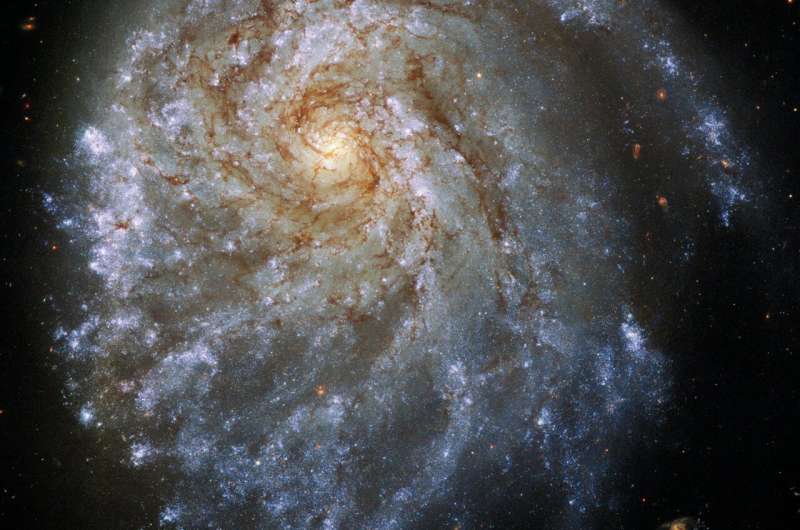Credit: NASA, ESA, STScI, Paul Sell (University of Florida)
The myriad spiral galaxies in our universe almost all look like fried eggs. A central bulge of aging stars is like the egg yolk, surrounded by a disk of stars that are the egg white. The galaxy in this Hubble photo looks like it is sliding off the frying pan. The central bulge is off in one corner relative to the surrounding disk of bright young blue stars. In reality, the stars on the right side of the galaxy are being pulled like taffy by the gravitational tug of a neighboring galaxy, not seen in this close-up view. Galaxies are not solid objects but tenuous agglomerations of tens of billions of stars. When two galaxies come close to each other they feel each other's gravity and are distorted, like pulling on cotton candy. It's the universe's equivalent of the 19th century children's poem about two stuffed animals—the gingham dog and calico cat—who got into a spat and ate each other. It's not so dramatic in this case. The galaxies are only getting a little chewed up because of their close proximity.
The magnificent spiral galaxy NGC 2276 looks a bit lopsided in this Hubble Space Telescope snapshot. A bright hub of older yellowish stars normally lies directly in the center of most spiral galaxies. But the bulge in NGC 2276 looks offset to the upper left.
What's going on?
In reality, a neighboring galaxy to the right of NGC 2276 (NGC 2300, not seen here) is gravitationally tugging on its disk of blue stars, pulling the stars on one side of the galaxy outward to distort the galaxy's normal fried-egg appearance.
This sort of "tug of war" between galaxies that pass close enough to feel each other's gravitational pull is not uncommon in the universe. But, like snowflakes, no two close encounters look exactly alike.
In addition, newborn and short-lived massive stars form a bright, blue arm along the upper left edge of NGC 2276. They trace out a lane of intense star formation. This may have been triggered by a prior collision with a dwarf galaxy. It could also be due to NGC 2276 plowing into the superheated gas that lies among galaxies in galaxy clusters. This would compress the gas to precipitate into stars, and trigger a firestorm of starbirth.
The spiral galaxy lies 120 million light-years away, in the northern constellation Cepheus.
Provided by ESA/Hubble Information Centre
























